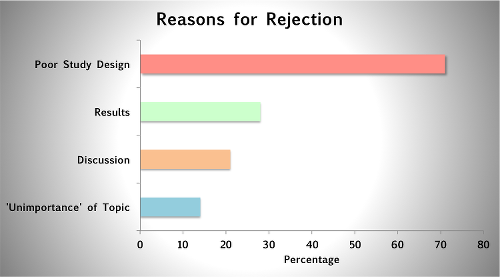Scientific journals receive numerous research manuscripts for publication consideration. The journal editors skim this pool of research papers, and with the help of reviewers, approve a set of manuscripts for publication.
Despite rigorous effort by authors, many manuscripts are rejected after peer review. Some reasons for rejection can be easily avoided if the researcher is conversant with the nitty-gritties of manuscript preparation and submission. In this article, I outline various aspects of a manuscript important for publication acceptance. The list by no means is exhaustive, and the selection criteria vary by journal and reviewer; nonetheless, it can serve as a useful guideline for first time authors.
- Topic related: with exceptions (e.g. Nature, Science), research journals generally cater to specific subject areas. Hence, the study topic is the first aspect that is considered.
- The editor first checks if the topic and research meet the journal’s field of interest, and its importance to research in the area.
- Next, during peer review, if research novelty is the journal’s priority, the reviewer checks whether the work presents a new perspective to existing knowledge.
- Writing and presentation: to a great extent, a research manuscript’s quality is determined by its written and presentation style. These aspects are important for effectively conveying findings to the target audience.
- Since journals have their own set of formatting rules, the editor will make sure that the author has followed all the journal’s ‘instructions to authors’.
- Some editors prepare a summary of the paper before sending it to the senior editor or the reviewers. Thus, if the paper clearly highlights the hypotheses, aims, methods, results, salient findings as well as the importance and limitations of those findings, it makes the review process smoother and more efficient.
- Reviewers also consider the written style, syntax, grammar, punctuation, organization of concepts and uniformity of presentation. Using the correct language and style, makes it easier for reviewers to concentrate on the science rather than getting ‘distracted’ by language
- Testing and data acquisition methods: research results can be authenticated only if they have been undertaken in an organized and logical manner. In addition, performing multiple tests, and the reproducibility of results are of primary importance in a research study.
- Experimental studies: reviewers look for adequacy and appropriateness of the test protocol, and if the study uses standard testing methods and testing equipment to conduct universally accepted experiments.
- Human studies involving questionnaires: the reviewers consider the design the author has followed while selecting subjects, scope, the types of questions that formed the questionnaire (for example open-ended or closed-ended questions), whether questions adequately addressed the research aims and any biases in either preparing the questionnaires or evaluating the results.
- Human trials: For studies involving experiments on human subjects (for example effectiveness of a new drug), the reviewers ensure that the experiments were ethically designed, and also how transparent the whole study protocol was for the participants.
- Reviewers pay special attention to any novel methodology reported in the study in order to check its logic, method of execution and feasibility. They make sure that the methods reported are indeed novel, and not just a rehash of old test methods.
- In all of the above cases, the reviewers check if all the important details of the test procedures have been documented, and if these details are adequate for other researchers to repeat if needed.
- Presentation of research arguments and discussion of findings
- Reviewers look for objectively explained results, and see if the author has made an in depth analysis of the test data.
- They analyze if the author has written the paper with clarity and brevity, conveying the research arguments in a precise convincing manner.
- Where appropriate, reviewers check if the data have been presented in tables and figures. They check for the format, uniformity and correctness of the data presented.
- They look for any assumptions or claims made by the author, and see how precisely and in a well-focused manner the author supports or proves his/her claims with the help of either published literature or the author’s own experimental data. Thus, compatibility and adequacy of the test data with that of the author’s claims are of prime importance. They make sure that the author is not overanalyzing the results, and in the process making unreasonable conclusions.
- Statistics plays a very important role in research, and hence the reviewers ensure that conclusions are made based on statistically significant data.
- They also check if the units of measurement are presented in the journal’s recommended system throughout the manuscript.
- They make sure that results already presented in the text have not been repeated in the tables or figures. Tables and figures should only support the text or help to quantify the findings.
- They assess how well the author highlights the importance, practicality and, where appropriate, clinical applicability of his/her work. Thus, the reviewers check if the work makes a valuable contribution to the general progress of scientific knowledge.
- If the author presents contradicting evidence to earlier studies, or reports a controversial topic, the reviewers will doubly make sure that the author has furnished enough evidence to support his/her claims. They will also verify that the author presents his/her research arguments in a respectful manner.
- The reviewers check if the authors have highlighted the limitations of their study, and if they have considered alternative explanations to their arguments.
- Review of published literature: past research work not only gives direction to future work, but also provides means to support current research.
- Reviewers check if an exhaustive and focused literature review has been done, and how the author claims his/her work to be different from already published research.
- They check if the latest published research has been referred to in the manuscript, and that very old or outdated data have not been used to form the basis of the research question.
A survey amongst editors and peer reviewers to understand the reasons for manuscript rejection by medical journals found the following: unimportance of the topic accounted for about 14% of the rejections, poor design of the study methods claimed a whopping 71% of the rejections, while the results and discussion sections were responsible for 28% and 21% of the rejections respectively.1 Thus, the study design must be robust, and the results and discussion sections must be presented well.
Familiarizing yourself with these reasons can help you avoid those mistakes, and ensure a better success rate. The peer review process is extensively comprehensive, hence, if the author pays particular attention to the minute details mentioned above, this process could be a smooth sailing one!
Reference
1. Byrne D.W., Common reasons for rejecting manuscripts at medical journals: a survey of editors and peer reviewers, Science Editor, Vol. 23 (2), 39-44, (2000).




